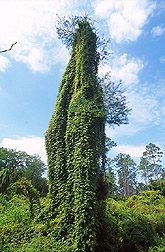This page has been archived and is being provided for reference purposes only. The page is no longer being updated, and therefore, links on the page may be invalid.
|
Read the magazine story to find out more. |
|
|
|
|
Stem-Destroying Insect May Help Conquer Climbing Fern
By Marcia WoodJuly 6, 2009
Throughout much of Florida's famed Everglades, an invasive, light-green vine called Old World climbing fern now cloaks the forest floor. Besides smothering shrubs and even small trees with its dense, spongy mats, the intrusive fern, known to scientists as Lygodium microphyllum, also forms soft, twining stems that climb tree trunks. Underneath this layer of living fern, dry, dead lygodium stems accumulate, boosting the wildfire hazard.
To help stop the fern's vertical and horizontal advance, Agricultural Research Service (ARS)-funded scientists at the Australian Biological Control Laboratory in Brisbane, and their ARS colleagues in Florida, have found and studied a coterie of insects that are natural enemies of the fern in its homelands—the tropics and subtropics of the Old World, including Australia.
Some of these beneficial insects have already been put to work in Florida. In the coming years, they may be joined by stem-boring moths, according to research entomologist Matthew Purcell. He's director of the Brisbane laboratory, which is operated by ARS and Australia's Commonwealth Scientific and Industrial Research Organization (CSIRO).
The female stem-boring moth—less than a half-inch from wingtip to wingtip—lays eggs that hatch into unusually long, cream-colored larvae. These slender caterpillars bore into the fern's stems to eat the pith.
For the fern, the invasion is catastrophic. A tunnel-boring larva has the potential to kill 40 feet or more of the fern, even if the tunnel itself is only a few feet in length. That's a strong punch for a half-inch-long caterpillar to deliver.
ARS-funded research overseas pinpointed stem borers' potential to control the fern in 1999. Subsequent expeditions—by Purcell; CSIRO colleagues Tony Wright, Jeff Makinson, Bradley Brown and Ryan Zonneveld; former Brisbane director John Goolsby, now with ARS in Weslaco, Texas; and Ted Center, with ARS in Ft. Lauderdale, Fla.—have yielded stem borers from several climbing fern species in Southeast Asia.
Among the most promising of these new candidates is a stem borer from Hong Kong. Importantly, the Brisbane scientists have been able to rear it in captivity, an essential step for completing requisite tests of its biology.
Read more about this research in the July 2009 issue of Agricultural Research magazine.
ARS is the principal intramural scientific research agency of the U.S. Department of Agriculture.

